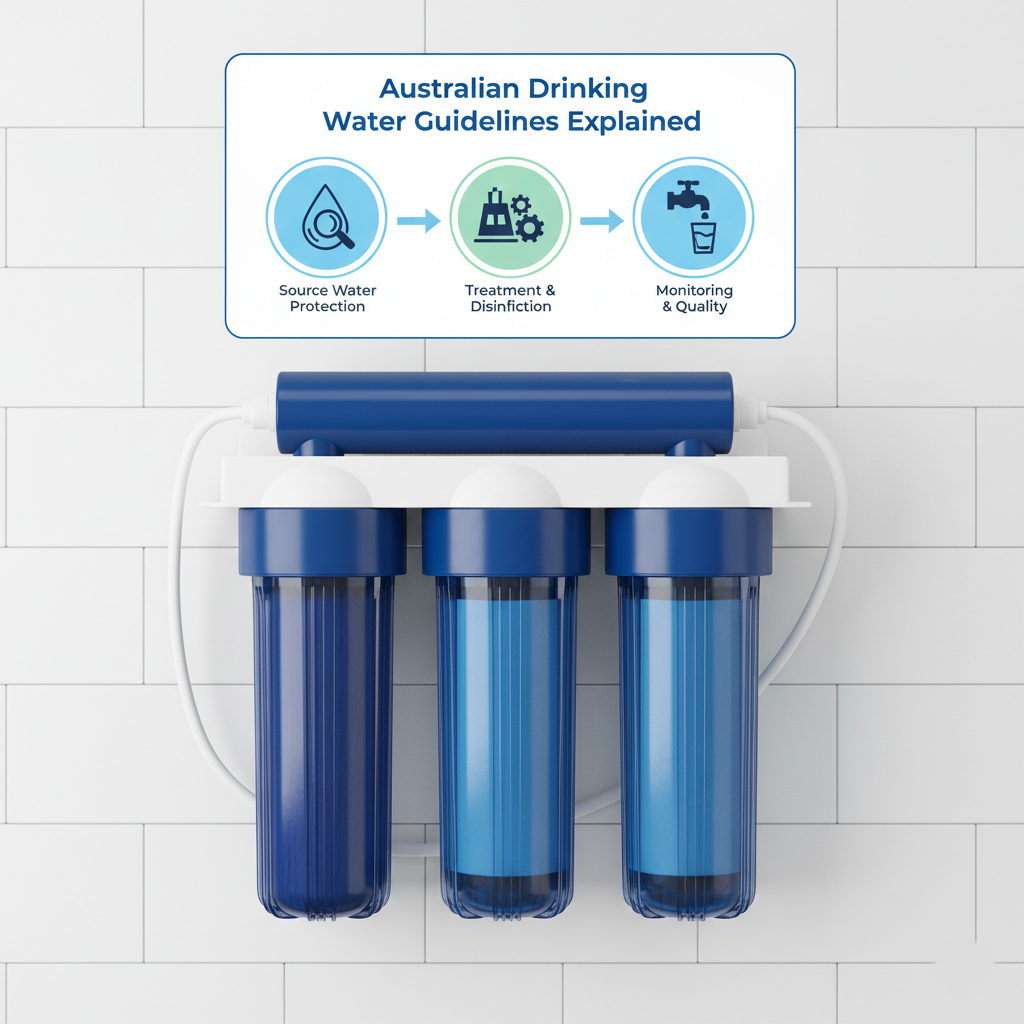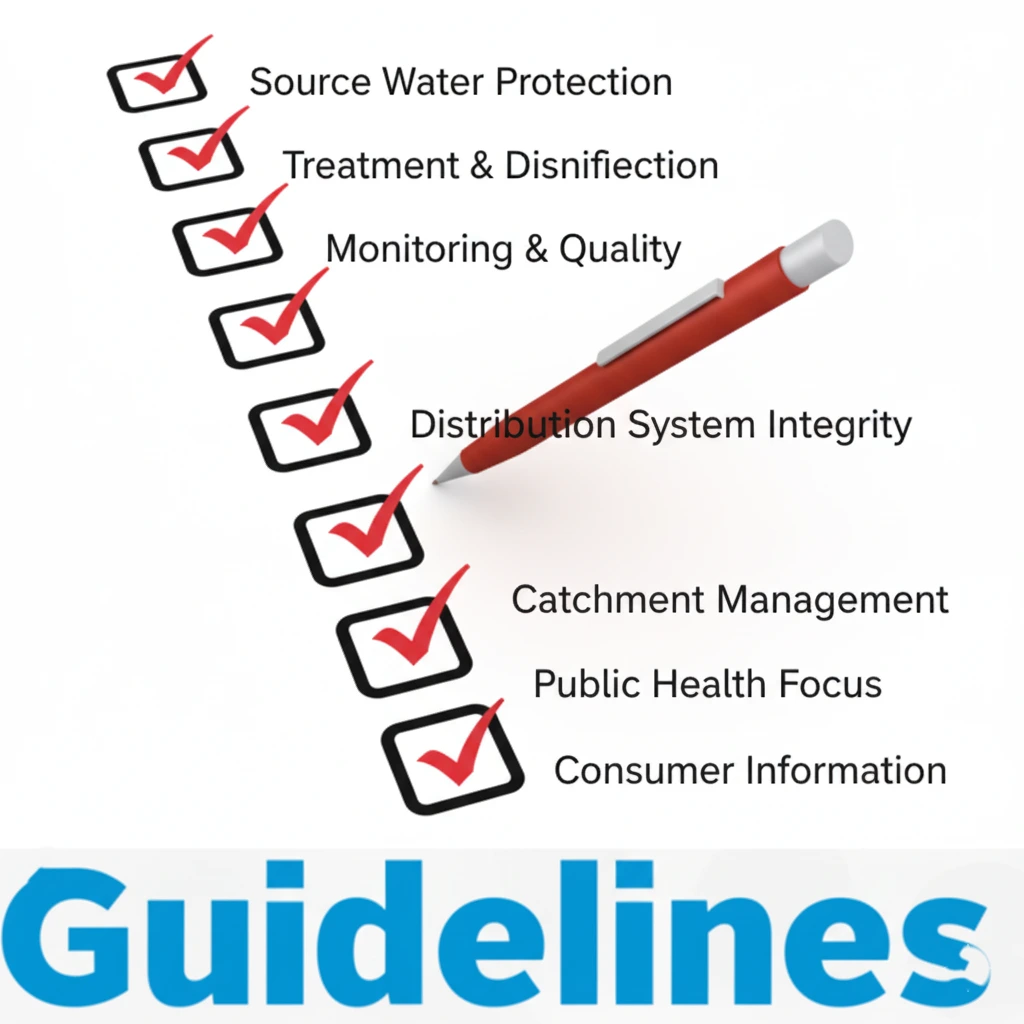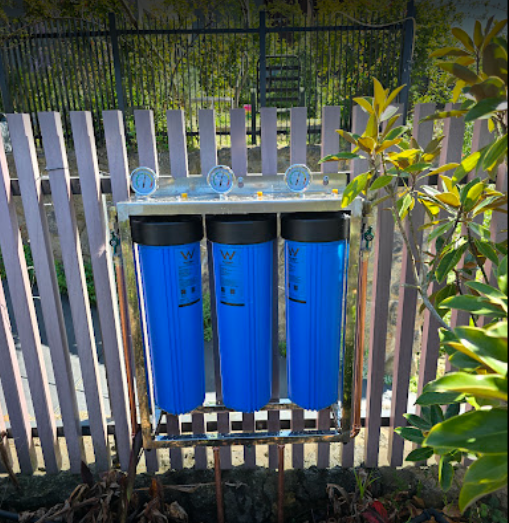Table of Contents

INTRODUCTION:
In this blog, we talk about the Australian Drinking Water Guidelines (ADWG) and what they mean for drinking quality in Australia, as well as where Reverse Osmosis (RO) systems come into play. Australians require clean, safe drinking water for good health and wellbeing. Such standards are extremely important as issues of water quality increase. One of the most successful approaches for water treatment, Reverse Osmosis (RO), also plays a key role in water safety and quality.
What Are the Australian Drinking Water Guidelines?
The purified water of the current invention relates to a standard filtered practice, which is established and maintained with two stages. The Framework will assist in the management of drinking water quality in Australia in maintaining and protecting public health and ensuring drinking water is safe, fit for consumption, and of an acceptable quality.
These standards are not just random rules; they have been developed based on a very thorough analysis of what health risks are presented by waterborne contaminants. The recommendations represent a wide variety of water quality elements from microbiological safety to the existence of chemical compounds, and ensure that the procedures in which water is taken care of get rid of contaminants thought to be harmful to health.
The ADWG contains both health-related (related to long-term risks) and aesthetic-based guidelines (such as taste, smell, or appearance of water). Health-based guidelines address contaminants such as lead, bacteria, and fluoride, while aesthetic-based guidelines consider factors like chlorine levels and turbidity.
As well as setting safe levels for drinking water, the ADWG highlights the need to manage risk and to treat drinking water effectively, so that any drinking water supplied to Australians complies with these high benchmarks.
Key Components of the Australian Drinking Water Guidelines
1. Microbiological Quality
One of the protocols that must be kept in place is microbiological ADWG (bacteria and viruses). The bacteria can cause severe waterborne illnesses, including gastrointestinal diseases. It sets acceptable thresholds for pathogens, such as E. coli and coliforms, which are indicators of fecal contamination. These microorganisms are not allowed in drinking water, and any detection requires immediate action.
The ADWG further states that, as insurance against waterborne diseases, it is recommended that treatment for microbiological impurity is at least disinfection, such as chlorination or UV treatment. To those locations that use untreated or poorly treated water, more treatment, such as Reverse Osmosis (RO) units, can provide a critical function in microbiological safety.
2. Chemical Contaminants
The ADWG also presents advice on hundreds of chemical pollutants, including heavy metals, pesticides, and industrial chemicals. Such chemicals can contaminate drinking water from industrial processes, as well as through the runoff of agricultural pesticides and corrosion of pipes. Over time, exposure to some chemicals can cause significant health issues.
Certainly, lead in drinking water is a serious issue, especially where older plumbing systems were used. There are maximum allowable levels for some chemicals (lead, nitrates, fluoride, and pesticides) set by the ADWG to ensure drinking water is safe.
It is especially effective on water with high chemical contamination by Reverse Osmosis systems. RO treatment is designed to remove a wide variety of substances, including heavy metals such as lead and arsenic, giving you cleaner and safer water for drinking.
3. Aesthetic Quality
The most important aspect of drinking water is its quality and health. Water that looks bad, with a taste or odor, or is cloudy, will deter drinking and suggest the presence of contaminants.
The ADWG has aesthetic limits for attributes such as humidity(cloudiness), color, taste, and odor. For example, high humidity may mean that there are suspended particles in your water that can contain bacteria or viruses. Likewise, bad taste or odor can signal the detection of chemicals such as chlorine and organic compounds.
RO systems can improve the taste and odor of water by reducing contaminants that contribute to flavor and odor problems, including chlorine/chloramines, TDS, and inorganic chemicals such as metals. With this in mind, RO is a great option for home or business owners looking to increase not only the safety of their drinking water but also enhance its taste.
How Reverse Osmosis (RO) Fits into the Australian Drinking Water Guidelines

Reverse Osmosis (RO) is a water purification technology that uses a partially open membrane to remove ions, molecules, and larger particles from drinking water. The black Berkey Purification Elements filter over 99.9% of pathogens and are a powerful method to filter both treated and untreated water.
Australian Drinking Water Guidelines demand a level of water treatment, and RO just falls in line with this. Here’s how:
Microbiological Safety
As we have seen already, the ADWG is concerned with microbiological safety. Although disinfection with methods such as chlorination is widespread, RO systems also provide an additional barrier by physically removing microorganisms. While RO is not intended to eliminate bacteria or viruses as chlorine does, it filters out pathogens larger than individual water molecules. This makes it great for homes wishing to minimize microorganism risks.
A few of the contemporary RO purification systems are equipped with a UV filter in their design, and this destroys any leftover microorganisms present in water to make it even safer. For areas in which there is a high prevalence of waterborne diseases or very poor-quality water, RO systems have a crucial role to play for public health.
Chemical Contaminant Removal
The ADWG places maximum permitted concentrations of chemicals in drinking water. ROs are especially good at chemical removal, such as heavy metals (lead, arsenic, mercury), which cause many health problems in drinking water.
RO membranes have very small pores, which allow water molecules to flow freely but block larger molecules like the majority of pollutants. This is what makes RO systems very good for removing harmful chemicals and will meet the MAC of a given chemical according to the ADWG.
Australians who live in places that are known for contamination, Aussies using well water must have an RO system so their water will be absolutely free from any unwanted substances and meet the safety levels.
Aesthetic Quality Improvement
Aesthetic characteristics of drinking water are significant for many Australians. Let’s look at the Australian Drinking Water Guidelines (ADWG), which state water must be clear, good-tasting, and free of odor. Water aesthetics are best improved with Reverse Osmosis systems.
RO systems are designed to make water taste better by removing chlorine, chloramines, organic compounds, as well as other elements that cause a bad taste and odor from your drinking water. An RO system can have a significant impact on water quality, even for households in urban areas with common chlorination, or in rural areas where the water may taste more earthy.
Compliant with Health Guidelines
RO systems can be constructed with many different types of filters and operating mechanisms to address specific health concerns (including fluoride and select heavy metals). Because the Australian Drinking Water Guidelines are always being revised, RO systems can be adjusted to combat any new chemical of concern and allow households to meet any new regulatory standards with which they must comply.
Furthermore, multiple RO systems undergo testing to satisfy NSP and WQA certification guidelines, which provide a guarantee of compliance with Australian as well as international specifications. This implies that selecting a certified RO system guarantees it to be compliant with, or superior to, the ADWG safety and performance standards.
Why is Reverse Osmosis Important in Australia?
Australia, having a wide range of climates and different water quality levels across the country, faces unique issues between different regions in relation to its water treatment. Although the majority (90%) of the urban population can access treated drinking water that complies with the ADWG (43), rural and remote populations can experience problems, including:
- High amounts of pollution from chemicals found in industry or farming
- Contamination by microorganisms as a result of inadequate water processing infrastructure
- Unattractive appearance of water from the community sources
For those Australians falling within these regions, the answer is a simple and yet affordable Reverse Osmosis water filtration system that will meet Australian Drinking Water standards. These are systems that provide water that is, at a minimum, free from harmful contaminants and impurities, but also aesthetically pleasing.
The Role of Reverse Osmosis in Rural and Remote Australia

Access to treated, safe drinking water in rural and remote areas of Australia can be restricted. These places could be subjected to water pollution by agricultural methods, industrial waste, and a lack of proper treatment facilities. Australian Drinking Water Guidelines provide a defined standard for safe drinking water, but in much of rural and remote Australia, water quality does not meet these standards.
This is where Reverse Osmosis (RO) units come in handy. They add an extra filtration layer to provide your body with only the safest, purest water that is free of added impurities and to ensure that you drink the cleanest, freshest water possible. Whatever the pollutant, whether it be high nitrates, pesticides, or microbial contaminants, RO systems can provide possible and affordable answers to making sure that people in rural and remote regions have clean drinking water.
The Importance of Regular Water Quality Monitoring in the ADWG
Monitoring of water quality is an essential part of assuring the safety of drinking water; as in other regulatory steps, it can be implemented through field work and laboratory testing. Water quality is known to vary because of seasonal Variations, pollution incidents, and variations in local water treatment methods. The ADWG considers that regular monitoring and testing of water quality are necessary to ensure that ongoing drinking water quality meets the requisite health and aesthetic standards.
Local water utilities and suppliers are mandated to test periodically for a variety of parameters, including bacteria, chemicals, or aesthetic attributes such as turbidity or taste. The drinking water guidelines list specific sampling frequencies and testing methods to determine whether the data is, indeed, representative and accurate.
In households with private water supplies, it is especially important to test regularly for contaminants. Reverse Osmosis (RO) solutions are important in this aspect as they act as an additional filtration mechanism, especially at places where water quality is not routinely tested. With the RO system, you will have assurance that your water is free from dangerous contaminants, even if water quality checks are less frequent.
Future Trends in Drinking Water Quality in Australia
For a country where drinking water quality is a reliable issue, with climate change, population growth, and industrial contaminants all threatening the integrity of Australia’s water supply. The Australian Drinking Water Guidelines will evolve to accommodate new contaminants and emerging developments. A growing focus will also be directed to water sustainability and other environmental drivers of innovation in water filtration technology.
Reverse Osmosis systems are poised to offer new levels of performance, in terms of energy usage and water wastage, and they will be able to take aim at new contaminants as they come along.
By continually reading and researching the ADWG and investing in certified water filter systems such as RO, Australians have peace of mind knowing their drinking water has been contamination-free, regardless of what the future holds.
Conclusion: Reverse Osmosis and the Future of Drinking Water in Australia
Knowledge of the Australian Drinking Water Guidelines is essential to maintain Australia’s standard drinking water quality that protects and benefits consumers. Although the criteria establish very high standards of water quality, contamination with chemicals, microbiological unsafety, or aesthetically undesirable characteristics is a common cause of inadequate protection in many parts of the world.
Reverse Osmosis (RO) systems are important for compliance with these perimeters as they offer a dependable way to remove harmful contaminants from your water supply, provide clean drinking water that tastes great, and offer protection against dangerous chemicals.
So, if you’re thinking of adding an additional layer to clean and filter your water from the tap up to ADWG standards at a minimum, and have great-tasting and safe drinking water, then consider using an RO system.
_edited_9.png)